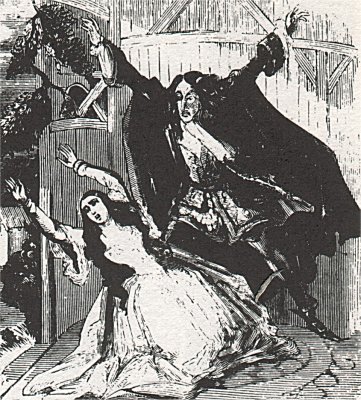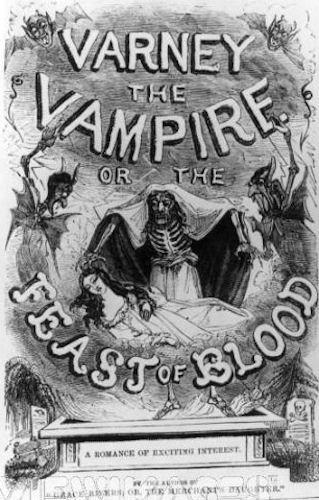 Real Name:
Sir Francis Varney
Real Name:
Sir Francis Varney
Varney the Vampyre
 Real Name:
Sir Francis Varney
Real Name:
Sir Francis Varney
Identity/Class: Vampire
Occupation: Rake
Affiliations: None known
Enemies: Unnamed vampire (turns up from London when Varney is living in Anderbury under the alias of Baron Stolmuyer of Saltzburgh. Varney kills him, but he is revived by the moonlight, attempts to rob Varney, and escapes); Admiral Bell (principal opponent in the first part of the story, but no real animosity between them)
Known Relatives: unnamed son (deceased)
Aliases: Slieghton, Mortimer
Base of Operations: Mobile across Europe
First Appearance: Varney the Vampire (penny dreadful, 1845)
Powers/Abilities: Varney had great strength. He could use his eyes to cast a glamour over his victims, but once he looked away, the effect comes to an end. Even without using his eyes, Varney could be very charming and entertaining. He could be killed, but is rejected by running water (such as rivers) and is revived by moonlight (a trait he shares with Lord Ruthven, the protagonist in John Polidori's The Vampyre). He can't walk up walls, although he seems to be good at scaling them or jumping on top of them.
 History:
The history of Sir Francis Varney is obfuscated, probably deliberately, by
conflicting tales told by the man himself. He claimed to have been active
during the reigns of Edward III and Henry IV; mentioned being an age of 180
years (although it's not clear whether this is the whole span of his life
or merely the length of time he's been a vampire; it would date him back
to the 1530s); there was a reference to a Sir Francis Varney during the reign
of Queen Elizabeth; his earliest recorded escapades were given a date of
1640 (when Marmaduke Bannerworth died and the time around which he had his
dealings with the Bannerworth family); but later he claimed to have become
a vampire in the early 1660s. He allegedly slew his own son in a fit of rage
late in the reign of Olver Cromwell. Varney also claimed to have been called
Slieghton during the reign of Edward III, and Mortimer during the Interregnum.
History:
The history of Sir Francis Varney is obfuscated, probably deliberately, by
conflicting tales told by the man himself. He claimed to have been active
during the reigns of Edward III and Henry IV; mentioned being an age of 180
years (although it's not clear whether this is the whole span of his life
or merely the length of time he's been a vampire; it would date him back
to the 1530s); there was a reference to a Sir Francis Varney during the reign
of Queen Elizabeth; his earliest recorded escapades were given a date of
1640 (when Marmaduke Bannerworth died and the time around which he had his
dealings with the Bannerworth family); but later he claimed to have become
a vampire in the early 1660s. He allegedly slew his own son in a fit of rage
late in the reign of Olver Cromwell. Varney also claimed to have been called
Slieghton during the reign of Edward III, and Mortimer during the Interregnum.
(Part 1) Varney attempted to recover a large sum of money from Bannerworth Hall, near the south coast of England and near Anderbury, where it had been hidden by Marmaduke Bannerworth, the former head of the family, who had committed suicide. Varney eventually succeeded, but the Bannerworths also recovered their fortunes.
(Part 2) Varney attempted a number of schemes to get married in order to break the curse which beset him. In Anderbury he once again encountered the Bannerworths.
(Part 3) Varney travelled to Italy, but continued to try and break his curse through marriage.
(Part 4) Back in London, Varney helped to save an heiress from being defrauded of her fortunes by her greedy uncle and aunt.
(Part 5) Deeply depressed, Varney trieed to end his existence by throwing himself into the sea from the ferry to Leith. His body was recovered by the Crofton brothers and he wais revived by moonlight. Vowing revenge, he turned Clara Crofton into a vampire, but lamented over her when she was staked by a mob.
(Part 6) Varney was persuaded to write something of his early history and told a tale of an adventure involving King Charles II and the Earl of Rochester. The story ends with a news report of Varney's suicide in the crater of Mount Vesuvius.
"You can keep that for your pains, and for coming into some danger with me. But the fact was, that I wanted a witness to an act which I have set my mind on performing... You will say that you accompanied Varney, the Vampyre to the crater of Mount Vesuvius and that, tired and disgusted with a life of horror, he flung himself in to prevent the possibility of a reanimation of his remains."
'Before, then, the guide could utter anything but a shriek, Varney took one tremendous leap, and disappeared into the burning mouth of the mountain.'
The only certain date in his history was Varney's final demise in Mount Vesuvius in 1713.
Comments: Thanks to Terry Hooper for pointing out to me that this character qualified for my website, and for providing information and images of him. Terry describes him thus: "The original super villain vampire: Varney the Vampire ran from 1845-47 and was sold weekly in 8pp parts for a penny. A rambling gore-fest is the best way to describe it! Varney eventually leapt into a volcano, killing himself but not before 220 chapters and almost a thousand pages had been printed!! Artist unknown (in the illustration above) and which 'hack' wrote it? Some say Prest though more likely is James Malcolm Ryder." It was certainly assumed until the 1960's that Varney had been created by Prest, but the discovery of some of Ryder's scrapbooks now show he is almost certainly the author.
Sir Frances Varney of Ratford Hall was one of the earliest vampires of popular fiction. Closer in style to the vampiric Orlok from "Nosferatu" than to Dracula, Varney would be killed dozens of times only to return. Finally he became disgusted with himself and his predatory existence, and committed suicide by jumping into the volcano Mount Vesuvius.
Varney is one of the first vampires to have fangs, as this quote shows - "With a plunge he seizes her neck in his fang-like teeth -- a gush of blood, and a hideous sucking noise follows." Bizarrely the author at first shied away from confirming the supernatural nature of Varney. At the end of his first meeting with a mortal family Varney reveals he had only pretended to have demonic powers in order to scare them, and later, when he is shown to be a vampire, Varney appears to be as surprised as everyone else.
Thanks to Bishop Antonio Hernandez for informing me of what powers Varney demonstrated, as well as adding the following comments: "What I can tell you is that Varney "had eyes like polished tin", which were very scary." He then mentions about Varney's lack of vampire powers and notes "That's why the character we know today that is closest to Varney is actually Barnabas Collins. They are very similar characters."
John Hutton added info on Varney's enemies, including "In truth, Varney has opponents rather than enemies. For example, Admiral Bell is his principal opponent in the first part of the story, but there's no real animosity. There is no one constant foil for him.", as well as relatives " son whom he killed in a sudden fit of temper. This is late in the rule of Oliver Cromwell. There are hints early in the story that he's actually one of the Bannerworths' ancestors, but this is never followed up." He also provided extensive expansions on Varney's powers and history.
Varney has a counterpart in the Marvel universe, as well as a namesake in that reality's oldest known vampire. He also gets namechecked in Kim Newman's Anno Dracula.
Thanks to James Franklin Jr. for drawing my attention to some minor corrections.
CLARIFICATIONS: Not to be confused with
any other vampires
Any Additions/Corrections? Please let me know.
All images and characters depicted on this site are copyright their respective holders, and are used for informational purposes only. No infringement is intended and copyrights remain at source.